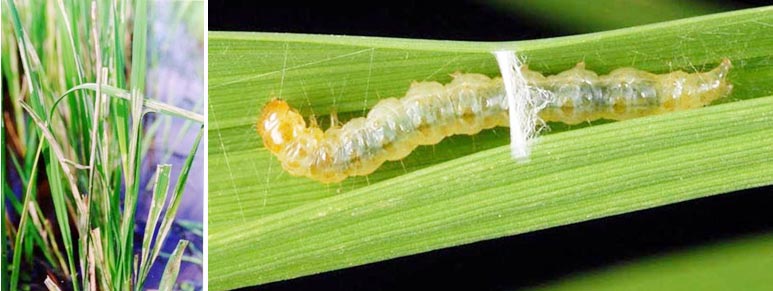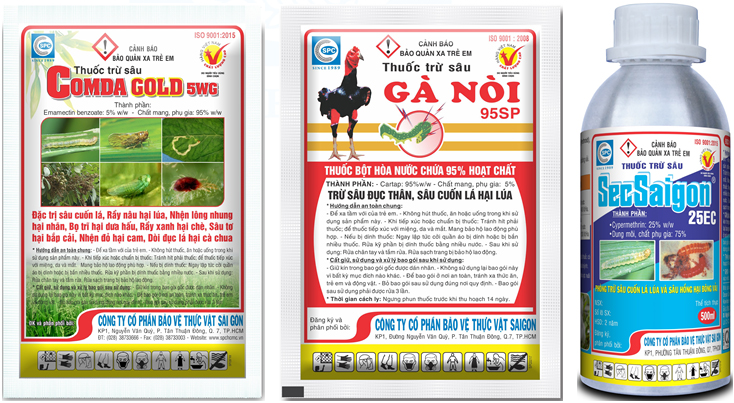|
Leaf Rollers
11/11/2021
MSc Huynh Kim Ngoc Leaf rollers are common pests of rice, widely distributed in rice growing areas in Asia, although leaf rollers are still considered as secondary pests, causing negligible damage. In Vietnam, in recent years, the rice area infected with leaf rollers ranks second after brown planthoppers, especially in areas where intensive rice cultivation uses a lot of nitrogen fertilizers. In the Mekong Delta, leaf rollers appear and cause damage all year round, but are common in Winter-Spring and Summer-Autumn crops.
Biological and harmful properties: Leaf rollers belong to the family Pyralidae/Lepidoptera. Scientific name: Cnaphalocrosis medinalis, Guenee. Moth (butterfly) has a pale yellow color, triangular wings, two horizontal stripes on the wings, the butterfly lays eggs on the leaves near the main veins, 4-7 days later hatching larvae on the leaf surface, the caterpillar has 5 typesof age, lasts 12-17 days. The caterpillar pupates right in the rolled leaf, the pupal stage is 5-7 days long, moth tends to like strong light. The life cycle of leaf rollers is about a month long (25-38 days). Leaf rollers cause damage by rolling and eating leaves. Newly hatched 1-year-old larvae usually lie on the old lesions or crawl to the top of the leaves. The second-year-old larva begins to damage by releasing silk that wraps the two edges of the leaf into a tube, lives and damages the inside by scraping the green tissue with chlorophyll, leaving the epidermis on the underside of the leaf, so the field is damaged by leaf rollers looks shriveled white. Due to leaf curl and loss of chlorophyll, photosynthesis is reduced, causing rice to be unfilled ,lower yield, in addition, the wound on the leaf edge is also an opening for bacteria that cause bacterial leaf blight disease and bacterial streak spots to invade and cause disease. The worst is at the time of heavy rain and strong wind. Usually in a leaf we only find one leaf roller and after the damage is done, the caterpillar crawls to the next leaf and continues to bite, on average, one caterpillar damages about 3-5 leaves. Observations at 40 days post-sowing - the most suitable time for pests - showed that one caterpillar eats an average of 25 cm2 of leaf area during its life cycle. However, this depends on 2 factors: (1) Age of the caterpillars and (2) The growth stage of rice, it was found that at the first 3 years of age, most caterpillars eat very little, about 10% of the area. leaves compared with the age of 4 - 5 and in the period of 80 - 100 days after sowing, the age of 1-3 caterpillars ate significantly lower leaves compared to the period of 40 - 60 days. The period of 40 days after sowing is considered the most suitable for all ages (Heong, L.K, IRRI). In addition to the main host is rice, leaf rollers are also found on corn, sorghum , sugarcane, beans, and weeds. Leaf rollers and yield losses. Research at IRRI in greenhouse conditions showed that when inoculating density of 3 worms / hill in the period 40 - 60 - 80 days after sowing, the results determined that there was no difference in biomass loss and yield. between treatmens. In actual field conditions, 10% - 60% leaf cutting showed a 5% - 12% decrease in yield respectively, however, nitrogen (N) fertilizer seems to partially compensate for this loss. A recent study at IRRI, showed that in the solid grain stage, with 10 - 20 leaf rollers/hill infestations, the biomass decreased by over 23% and the yield decreased significantly, but in reality with Such high concentrations of infection are rare. In Vietnam, many studies show that the early appearance of leaf rollers does not reduce yield, but in the later stages: Booting stages if the field is heavily damaged by leaf rollers, it can affect the development of the spikes and grains (short spike, fewer grains, reduced grain weight) or can cause rice in bloom with choked earing , short panicles, unfilled grains but if this period has weather abnormalities ( drought...), soil (alum, salinity...), pests (hoppers, stem borers...), these synergistic effects can still affect rice yield. Natural enemies of leafrollers: Natural enemies of leaf rollers are very diverse, including: + Parasites: Eggparasites:-Polyembryonic wasp(Copidosomopsis nacoleiae),Trochogramma japonicum... Larvae parasites: cự wasp (Itoplectis narangaea), Golden brown cự (wasp Temelucha philippinensis)... + Predatory group: Tripod beetle (Ophionea nigro fasiata), cricket (Metioche vittaticolis), damselfly (Agriocnemis pymaea), ringlegged earwig (Euborelia stali) + Pathogenic group: fungus Beauveria bassianae, fungus Nomuraea rileyi Of the three groups above, the parasitic natural enemy is the most important in controlling leaf roller outbreak Prevention: + Cultivation according to the method of integrated prevention and control: sowing at the same time, not sowing thickly, fertilizing in a balanced and reasonable manner, not over-fertilizing nitrogen, applying nitrogen late, border weeding + Protect natural enemies. + If leaf rollers appear with a high density, especially at the time of the earing and blooming stages, which has the potential to harm yield, it must be sprayed immediately. Attention should be paid to the effectiveness of: (1) spraying early when they are larvae (2) spraying with the recommended amount of water, (3) spraying should be rotated because leaf rollers develop resistance relatively quickly, (4) Should be sprayed in the early morning (wet wings, slow flight) or cool afternoon, (5) products that can be used to treat leaf rollers: Comda gold 5WG, Sec Saigon 25EC, Gà Nòi 95SP. |
To prevent, in addition to plowing and burying weed seeds, collecting weed stalks and stumps left after tilling the land to burn, not letting weeds produce seeds in production fields, etc., the use of chemical products is still a measure. optimal because of its ability to thoroughly kill weeds, reduce labor and take advantage of more time than manual weeding.
Miner has the scientific name Phyllocnistis citrella Staint., family Phyllocnistidae, order Lepidoptera. The miner occurs in many countries in the tropics and subtropics. The main host of the miner is the citrus family - Rutaceae. In addition, the miner also attacks mangosteen and some other plants.
Adult is a small planthopper, with a body 2-3 mm long, the whole body is ash gray, slightly greenish, the wings are opaque with many small brown spots.Eggs are oval, 0.3 mm long, have a pointed end and are attached directly to the leaf surface, leaf axils.
Green bugs specialize in the fruit of citrus groups (oranges, tangerines, lemons, grapefruits, kumquats...), some people call them orange bugs, or orange suckers. Their scientific name is Rhynchocoris poseidon or Rhynchocoris humeralis.
In Vietnam, yellow leaf curl disease is very common on papaya trees, especially the disease is often severe in areas of high and continuous planting, areas with hot and arid climates. The disease has significantly reduced the yield and quality of papaya. Gardens that are infected early when the plants are young may not yield. However, up to now, many gardeners still do not know the cause and how to fix it.
Spider mites are common pests on citrus trees, especially in hot and dry climates that are suitable for spiders to grow and cause severe damage.The group of harmful spiders is usually very small in size, unlike the natural enemy spiders.
This group includes species that are generally very small in size, causing damage by sucking plant sap (on leaves, fruits, branches, stems).
There are many species of mealybugs present on the group of Oranges,Tangerines,Grapefruits and Lemons (Citrus), which can be divided into 2 groups:
+ Group of sticky mealybugs with common varieties such as Lepidosaphes, Aonidiella, Coccus and Saissetia.
+ Group of flower mealybugs with common genera and species such as Pseudococcus, Planococcus and Icerya purchasi.
Dry branches and berries disease often appear to be common damage on coffee gardens during the rainy season. The disease causes death of branchs, dry fruit, severely affects the canopy structure and coffee yield if not paid attention to prevention.
Pink disease commonly causes diseases on rubber plantations in the rainy season, especially on garden from 4-8 years old. This year, rubber has to go through a period of severe drought, weakening the tree, so now in tnshe rainy season it is easy to get infected. Therefore, it is necessary to pay attention to good management to avoid affecting the garden.
In recent years, the area of citrus has been expanded because it is a fruit tree with high economic efficiency. However, in order to sell at a high price, not only in quality but consumers also require the external beauty of the fruit, so pest management on citrus is a matter of great concern to farmers. The hot season is a favorable condition for thrips to develop and cause damage, affecting the commercial value of fruit.
- Headquarters
- SAIGON PLANT PROTECTION JOINT STOCK COMPANY
- RQ 1, Nguyen Van Quy St., Tan Thuan Ward, HCM City
- Tax code: 0300632232
- Tel: (028) 38 733 295 - 38 732 077
- Fax: (028) 38 733 003 - 38 733 391
- Website: www.spchcmc.vn - Email: info@spchcmc.vn
- SAIGON PLANT PROTECTION COMPANY
- SAIGON PLANT PROTECTION JOINT STOCK ENTERPRISE
- Lot C1-C3 Hiep Phuoc Industrial Park, Hiep Phuoc Commune, HCM City
- Tel: (028) 3873 4089 - Fax: (028) 3873 4086
- Affiliated Unit
-
- Quick Links
- Home
- About us
- Career Opportunities













